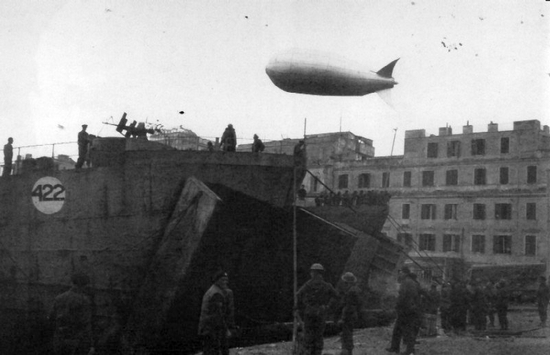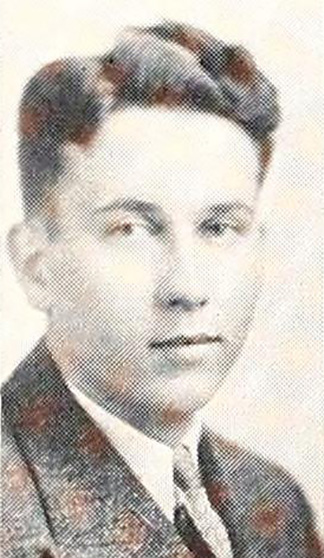Ralph T. Rankin
Date of Birth: May 3, 1915
Place of Birth: Le Roy, Coffey Co., Kansas
Father and Mother’s Names: Ralph Walker Rankin and Della Mabel (Thornton) Rankin
Spouse and Children's Names: Velda Frances (Umbach) Rankin and a daughter (name unknown)
Date Entered Service: 1942 from Oklahoma City, Oklahoma.
Service Branch: Army
Rank/Specialty: First Lieutenant
Service ID: 0-365551
Division/Company/Unit info: 83rd Chemical Mortar Battalion
Awards and Commendations: Purple Heart and the Silver Star
Riley Connection: In 1925 Ralph and brother, Wallace, lived with their parents at 731 Osage St. in Manhattan, Kansas. The Rankin family continued to live there till at least 1930. Ralph attended Kansas State College in Manhattan from 1935-1937. Ralph T. Rankin has a stained glass memorial window dedicated to him located in the All-Faiths Chapel on the Kansas State University Campus.
Date of Death (and Age): January 26, 1944 (age 28) - First listed as MIA (Missing in Action) but later declared KIA (Killed in Action). His body was never recovered.
Place of Death: Tyrrhenian Sea, Southern Italy (lost at Sea)
Grave Location: Name listed on the Tablets of the Missing, Sicily-Rome American Cemetery and Memorial, Nettuno, Città Metropolitana di Roma Capitale, Lazio, Italy.
Bio: Ralph's father was working as a traveling hardware salesman and while still a young lad his family moved from Le Roy to Manhattan, Kansas and lived at 731 Osage St. Ralph attended Kansas State College from 1935-1937 and was a member of the Alpha Tau Omega Fraternity. Ralph met and married Velda F. Umbach. He met Velda while both were in college. By 1940, Ralph and his wife moved from Manhattan to Oklahoma City, Oklahoma where Ralph worked as a traveling electric appliance salesman, following in his father's footsteps. In 1942, Ralph joined the Army and became a 1st Lieutenant attached to the 83rd Chemical Mortar Battalion. On January 26th, 1944 Ralph and his unit were at sea near the Italian city of Anzio. They were to land in the LST-422 onto the beachead at Anzio and relieve other units who were fighting their way to Rome. Before his ship could reach the beachead, it was sunk. Many died in the sea, including Ralph, and were never recovered. Ralph was awarded a Purple Heart and the Silver Star. As always in times of crisis, individual Americans took it upon themselves to risk their own lives to save others.
The Sinking of LST-422: LST-422 was Lend-Leased to Great Britain in late 1942. As part of the Royal Navy, she was captained and crewed by British Naval personnel, although she was in this case transporting American personnel, arms, and equipment. LST-422 departed Naples, Italy the night of January 25, 1944, loaded to capacity with trucks, Jeeps, M3 halftracks, ambulances, and other vehicles. She also carried many 50-gallon steel barrels of gasoline lashed to the deck, plus a variety of ammunition. The personnel were Companies C, D and Headquarters of the American unit 83rd Chemical Battalion, Motorized. This unit operated batteries of 4.2" mortars, firing white phosphorous, smoke, gas, and high explosive shells. Many of the trucks were loaded containing the very volatile white phosphorous 4.2 inch mortar shells. The LST-422 was part of a convoy of 13 LSTs. She was commanded by Lieutenant Commander Broadhurst, Royal Navy. In his report on the sinking of the LST-422 he wrote:
"It was noted in the ships log that the weather was deteriorating all the time the ships were in convoy. The wind veered from southerly to westerly Force 8 (gale). If the ships were allowed to fall just one point from the wind they would not steer. LST 11 and 65 (in a different convoy) collided and several other incidents were narrowly averted."
The LST-422 arrived off the coast of Anzio, Italy without incident about 1:00 A.M. on January 26, and set anchor due to the backlog of ships unloading at the Anzio docks. During those early hours an intense storm whipped up with gale wind velocity and waves 20 to 30 feet high. The winds blew the LST into a known mine field, about 12 miles offshore. At 0520 hours, Captain Broadhurst was resting in a bunk built by the ship's magnetic compass, when a flash was followed by a terrific explosion toppled the compass onto Captain Broadhurst. He managed to slide from beneath it and make his way to the bridge. The resulting explosion had blown a huge hole in the bottom and starboard side of the ship, and the ship's fuel oil supply had immediately ignited.
From the bridge, Broadhurst could see twenty foot flames coming from all the tank deck ventilators. The vehicles in the tank space deck had begun to explode, which had set fire to the ship's diesel fuel oil, much of which had been sprayed out the moment lST-422 hit the mine. The explosion had ripped a massive fifty foot hole on the starboard side in the region between the main and auxiliary engine rooms.
Most of the men of the 83rd Chemical Mortar Battalion were asleep in the tank deck, which was the first to flood. It sealed the fate of over four hundred men who had no chance of getting out. The men on the main deck had a grim ultimatum.......abandon ship or be consumed by the raging inferno.
The after hatch collapsed allowing exploding ammunition and rockets to escape, then fall onto the vehicles on the upper deck. Tanks of gasoline had been fractured by shrapnel and within two minutes the entire upper deck was a sheet of flame. Soon the bridge was on fire, and the ship's LCP (Landing Craft- Personnel) was ablaze and fell into the sea from its davits. Captain Broadhurst was unable to contact the engine room, all power had been lost. It was found to be impossible to reach the mess deck where the smoke helmets and asbestos suits were kept. An attempt was made to start the auxiliary fire foam motor, but this had been damaged by flying metal from the exploding objects.
U.S. Army personnel were ordered to abandon ship. Only four Carly floats (life rafts) were left undamaged, so all floatable materials such as loose timber, oil drums, and such were thrown overboard to assist the men in the water.
Many of those who took to the water perished in the frigid sea before anyone could come to their rescue. LST-301 stood nearby to assist. Sadly, one of the men who had escaped LST-422 was picked up by LST-301 but fell to his death between the 301 and LS-422. The disaster was compounded when LCI-32, which had gone to assist LST-422, hit a mine and sunk herself. 30 of her crew were lost, and 11 wounded. Rescues were effected by the minesweepers USS Pilot, USS Strive, LST-16, YMS-34, YMS-43, and other YMS craft. 150 survivors of LST-422 and LCI-32 were rescued from the water in storm conditions.
The information available for this veteran is incomplete. We would like to include as much information about all our veterans as possible, so if you or someone you know has any additional information we encourage you to contact us at: peacememorialmanhattan@gmail.com. Thank you for your support.

